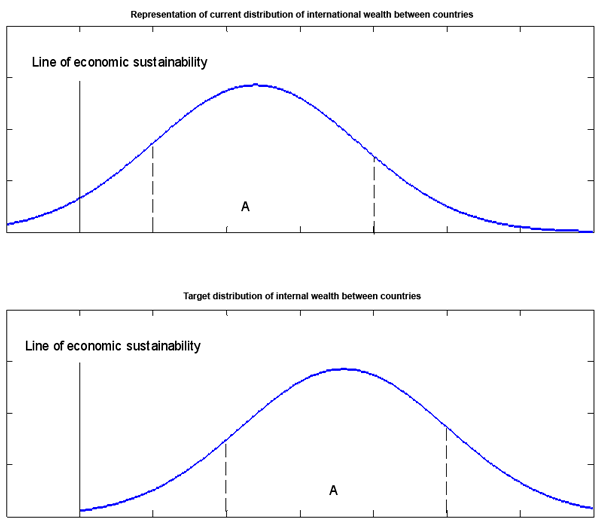Earthquakes that have caused damage to developing countries have averaged a magnitude of 7.1 and claimed 277,271 lives (assuming a final death toll from the 2004 Boxing Day tsunami of 230,000). This suggests developing countries, relative to developed countries, have experienced shocks of approximately 0.5 greater magnitude (7.1 versus 6.6) and a death toll in the order of 40 times greater (277,271 versus 6,564). The on-average greater intensity of the earthquakes to have struck developing countries seems to be of a disproportionately low magnitude, relative to the higher death rates.
It is true that the tsunami was a different kind of disaster, compared to land-based earthquakes, such that the damage caused and the number of lives lost as a result of the tsunami may be atypical. However, the pattern of a disproportionately greater number of deaths in developing, relative to developed, countries holds when the tsunami is excluded from the comparison.
In that scenario, developing countries have experienced earthquakes of a comparable average magnitude (6.5 versus 6.6), but have experienced a death toll approximately seven to eight times greater (47,271 versus 6,564). Given the strength of this pattern, it is hardly surprising that it appears applicable elsewhere: in Sub-Saharan Africa, for example, the estimated HIV-AIDS prevalence rate of 7.4 per cent of the adult population compares to 0.2 per cent in Oceania and 0.6 per cent in North America.
Advertisement
These observations provide a compelling argument that the economic fragility of developing countries increases their vulnerability to public health disasters disproportionately, and raises the possibility of economic development as an effective lever for minimising the impact of such disasters. There appear to be two complementary possibilities: reduce economic inequities between countries, and improve public health infrastructure within developing countries.
One way to reduce economic inequities between countries is through aid programs. An examination of current financial assistance from developed countries to developing countries, however, shows only five (Sweden, Luxembourg, The Netherlands, Denmark and Norway) meet the UN target of donating 0.7 per cent of Gross National Income (GNI). In 2004-2005, Australia committed 0.26 per cent of its GNI, or 26 cents for every $100 earned. Even if developed countries perceive the UN target as unreasonable, there are other opportunities to promote greater equity: fairer trade deals, if not compassionate deals that actually favour poorer countries; ongoing reduction or cancellation of Third-World debt; and provision of a lower proportion of tied aid.
The argument for greater assistance from developed countries does not necessarily mean that they will be relatively economically worse off then they are currently. One way to demonstrate this is in terms of a Bell curve.
Figure One: Current and target distributions of wealth between countries

Figure One delineates a basic relationship between the levels of economic wealth of different countries, where most countries may fall into the middle, or average, section (section A), some countries are below average (they sit on the curve to the left of section A) and some countries are above average (to the right of section A).
Advertisement
There are two crucial points here. First, the current distribution graph shows that a number of countries of below average economic wealth are also below (that is, to the left) of the arbitrary economic sustainability line, while the target distribution graph shows a shift of the whole curve to the right, such that no countries are below the economic sustainability line. Second, the shape of the curve is preserved despite the shift to the right: some countries are still more economically wealthy than others, but no countries are left below the line of economic sustainability.
In addition to a more equitable distribution of global wealth, developing countries should continue to work to improve their domestic economies, thereby increasing the likelihood they will obtain more effective international economic assistance.
Although leaders from developed countries have reasonably expressed concern about the use of foreign aid in some countries, it is not reasonable for assistance from developed countries to be exclusively dependent on the elimination of corruption in the domestic economies of developing countries. Corruption within public offices is both a cause and a symptom of economic hardship and, indeed, the example of developed countries suggests corruption will be reduced, or at least become less visible, by economic development. Such concern is clearly indefensible if it is used to justify the maintenance of a manifestly inequitable allocation of global wealth.
In summary, although the short-term response to the 2004 Boxing Day tsunami appears to have been reasonable, the greatest international response failure is the obvious unwillingness to seriously consider increased economic equity between developed and developing countries, as the most effective longer-term strategy to reduce harms associated with public health disasters.
Despite the short-term strategies implemented, the July 17, 2006 tsunami still resulted in a loss of life in the order of 10 times that which occurred over 15 years ago as a result of the San Francisco and Los Angeles earthquakes. The economies of Third-World countries must be developed.
Acknowledgements: Mr Stuart Gilmour (Statistician, University of NSW) produced the graphic. He, along with Associate Professor James C. Frankish (Assistant Director, Institute for Health Promotion Research, University of British Columbia, Canada) and Associate Professor Christopher Doran (NDARC, University of NSW) provided valuable improvements to the essay.